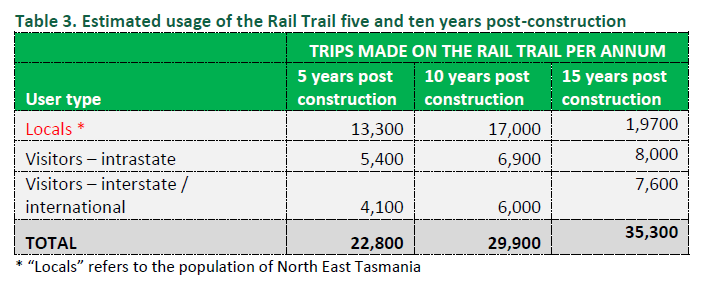FAQs – Frequently Asked Questions
North East Recreation Trail – Tasmania
Click on the icon toggle to display the answer to each question.
What is a rail trail?
Rail trails are shared-use paths recycled from abandoned railway corridors. They can be used for walking, cycling and horse riding (where appropriate).
There are rail trails around Australia and overseas.
Most trails have a gravel or dirt surface though some have a sealed surface.
What is proposed for this project?
The successful funding application involved constructing a rail trail from Launceston to Scottsdale along the abandoned North East railway line. The route from central Launceston is still being decided, but would join the former 70 kilometre North East railway (between Launceston and Scottsdale) to the point where the line branches from the still-used Bell Bay line, near Rocherlea. The rail trail would run to Scottsdale. It would then continue along the existing 28km rail trail constructed by the Rotary Club of Scottsdale to Billycock Hill.
What would the rail trail look like?
The rail and sleepers will be removed and the ballast (rock under the sleepers) crushed. It would be mixed with fine gravel to create a smooth riding surface. There would be direction and interpretation signs and toilets at regular intervals, as well as safety barriers at road crossings.
An example, the Central Otago Rail Trail can be viewed at: https://www.youtube.com/watch?v=CWEbUrO37Jk
How steep is the track?
Rail corridors typically have a gradient of less than 2 per cent, making them ideal for walking and cycling by people of all abilities.
Who owns the land and who would build and operate the rail trail?
The rail corridor is a rail reserve, meaning it is public land set aside for use as a railway. The Corridor is owned by the Crown and was previously leased to TasRail for the purposes of operating a railway. Dorset Council will take over the lease of the corridor and manage the construction of the trail. A volunteer community-based group will be responsible for trail maintenance once it is constructed.
Are there privacy and safety issues?
The land is already public space and having cyclists and others on the track is a lot less noisy than trains. Motorcycles and other vehicles with engines are not allowed. The majority of users would be families or early retirees seeking exercise and to enjoy nature in peace and safety.
Has there been consultation with the community?
As part of our travel and research, we have asked other rail trail managers how they consulted with local residents and community. On their advice, we wrote a letter on October 17, 2014 to more than 130 landowners identified by the Launceston City Council and the Dorset Council as owning land adjacent to the rail corridor. This letter, headed North East Rail Trail Project, contained information about the proposed project, the fabulous work completed by Scottsdale Rotary, detail about the formation of our voluntary board and contact details for Susie Bower, Economic Development Manager at Dorset Council, for any person requiring further information.
We received about 14 responses. Some people rang to ask about investment opportunities. Some people rang to say they did not support the project but could not identify any specific issues that we could work with them to resolve.
Four residents raised legitimate concerns. As a result, we met with each of these at their homes to listen to their concerns, provide workable solutions where possible or to take their concerns on board and return once we had options.
We are continuing to work with the landowners and have consulted NRM North concerning the erection of privacy vegetative screens, requested quotes for privacy fences, presented options for cement crossings with automatic gates for stock and much more. This is an ongoing process.
Do other rail trails have issues with personal safety and theft?
Typically, the demographics of people riding rail trails are families and early retirees in their 50s and 60s that have above average personal wealth, are well educated, enjoy light exercise and are more likely to spend money when they travel. They are not interested in jumping fences to steal livestock or machinery (and cart them away on the back of their bike) or to threaten families or interfere with other people’s living or business.
Rail Trails are all about riding and walking on a formed track in a fenced corridor for exercise and enjoyment.
What about fire and weeds?
Weeds that emerge on the rail reserve will be kept under control as part of the project’s maintenance schedule. Open fires will not be allowed.
What about stock, animals and biosecurity?
The trail will be fenced, so stock will not be impacted, and stock crossings will be included, if needed. Walkers may be allowed to bring pets, but animals must be on a lead and under control at all times. No biosecurity issues are expected, as riders will be on a dedicated track and not impacting on neighbouring properties.
What is the expected economic and social impact?
Rail trails in other states and countries continue to be big income drivers for their areas. The project can be expected to generate jobs and significant economic activity. The social impact should be significant, with a new option for exercise and enjoying the scenery for both locals and tourists. An economic Benefit Assessment of the North East Rail Trail, prepared for Northern Tasmania Development by TRC Consultants, shows more than 23,000 people
would walk or cycle the trail each year, growing to 35,000 trips after 15 years. And similar trails, such as the Central Otago Rail Trail in New Zealand and the Murray to the Mountains Rail Trail in Victoria, now attract up to 45,000 people a year and estimate hundreds of jobs have been created through construction and tourism service delivery.
Rail Trails provide significant amenity and health benefits to communities by encouraging safe outdoor exercise.
How many jobs are likely to be created?
Gross State Product is estimated to increase to $5.3 million per annum from increased economic activity of over $11 million, supporting an estimated 40 Full Time Equivalent jobs five years post construction and at 15 years post construction 67 long term FTE positions (see tables below). The economic benefit to society of motivating an inactive person to walk or cycle is estimated to be between $5,000 and $7,000 per year.
Forecast Projections for the North East Recreation Trail (as originally proposed) – Sourced from: NE Rail Trail Preliminary Demand and Economic Benefit Assessment, TRC Tourism for Northern Tasmania Development


What are the business opportunities?
Plans are already being prepared for B&Bs, luxury and hostel-style accommodation, conference centres, boutique breweries, bike hire businesses, tour companies, restaurants, cafes, art galleries, open farms, vineyards, farm gate experiences and much more. The options are endless…
…As the Blue Derby development has shown, where opportunity arises there are abundant entrepreneurs ready to engage.
How will motor bikes be kept off?
Evidence from other trails around the world suggests the two best options for keeping motorbikes or other motorised vehicles off the trail are to erect chicanes at regular intervals that cyclists can manoeuvre through (but not motorcycles) and once a larger volume of walkers and cyclists utilise the trail, motorbikes tend to disappear. Not one of the trail managers we have spoken to has said that motorbikes are an issue on their rail trails.
What will be the long-term cost to Local and State Government?
We are proposing a self-funding model that will enable North East Recreation Trail Inc. to manage the trail long term. Funds from a Friends of the Rail Trail membership program, as well as business membership, has worked on numerous trails around the world to provide the estimated $25,000 required to maintain the trail each year. We also propose to involve service clubs, Landcare groups and other volunteers to assist with general maintenance such as clearing the track, if required.
Can emergency vehicles access the track if there was an accident?
As part of the track’s construction plan, there will be points where emergency vehicles can access the trail. This is a regular feature of rail trails around the world, including the 28km currently operating from Scottsdale.
What about rubbish and litter along the trail?
Other rail trails report the best option for eliminating rubbish is to not place rubbish bins along the trail, instead installing signs at the trail head asking people to carry their rubbish out with them. Trails that did install rubbish bins found that they were often vandalised and were left overflowing but reported a 100% improvement with responsible cyclists and walkers taking their rubbish with them.
What will it cost to use the trail?
The trail will be free for locals and tourists to use. It is anticipated that locals will love using the corridor to walk, ride and exercise. We will however have donation boxes along the trail so that people can show their appreciation for the volunteers who look after their trail and assist.
Will a scenic corridor be imposed on local landowners?
The rail trail Board has no intention of requesting the respective councils to declare a scenic corridor over the length of the rail corridor. To do this, both Councils would have to amend their planning schemes and would only do so if requested by the community. As a further safeguard, the Board has offered local farmers representation on the Board to ensure that this can never occur.
Where can I obtain more information?
You can visit the following websites for more information about rail trails:
